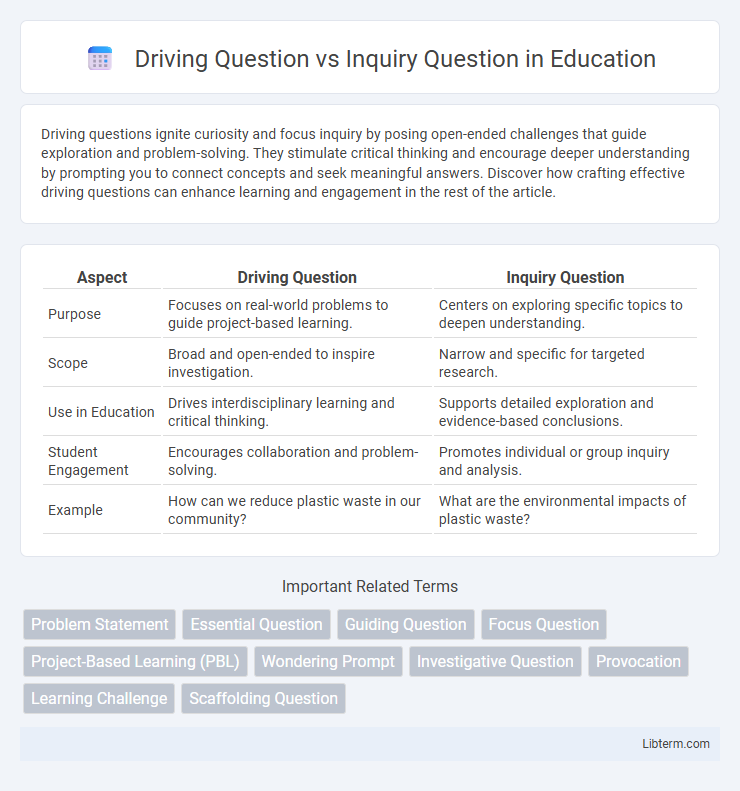Driving questions ignite curiosity and focus inquiry by posing open-ended challenges that guide exploration and problem-solving. They stimulate critical thinking and encourage deeper understanding by prompting you to connect concepts and seek meaningful answers. Discover how crafting effective driving questions can enhance learning and engagement in the rest of the article.
Table of Comparison
| Aspect | Driving Question | Inquiry Question |
|---|---|---|
| Purpose | Focuses on real-world problems to guide project-based learning. | Centers on exploring specific topics to deepen understanding. |
| Scope | Broad and open-ended to inspire investigation. | Narrow and specific for targeted research. |
| Use in Education | Drives interdisciplinary learning and critical thinking. | Supports detailed exploration and evidence-based conclusions. |
| Student Engagement | Encourages collaboration and problem-solving. | Promotes individual or group inquiry and analysis. |
| Example | How can we reduce plastic waste in our community? | What are the environmental impacts of plastic waste? |
Understanding Driving Questions
Driving questions serve as central, open-ended prompts that guide the entire inquiry process by sparking curiosity and framing the scope of exploration. They are designed to be broad yet focused enough to connect multiple disciplines and promote deep understanding of complex concepts. Understanding driving questions involves recognizing their role in motivating sustained investigation and encouraging learners to apply critical thinking and problem-solving skills throughout their inquiry.
Defining Inquiry Questions
Inquiry questions are open-ended prompts designed to guide research and exploration, encouraging critical thinking and deeper understanding of a topic. They focus on the why and how aspects, promoting analysis, evaluation, and synthesis of information rather than simple factual recall. Unlike driving questions that set the broad purpose for a project, inquiry questions narrow the investigation into specific, researchable issues essential for meaningful learning outcomes.
Key Differences Between Driving and Inquiry Questions
Driving questions are open-ended, broad prompts designed to guide sustained investigation and foster student motivation, typically framing long-term projects or problems. Inquiry questions are more focused, specific, and aimed at guiding the research process or clarifying particular aspects within the broader framework set by the driving question. Key differences include the scope--driving questions inspire big-picture exploration, whereas inquiry questions facilitate targeted information gathering and analysis.
Purposes of Driving Questions in Learning
Driving questions in learning serve to ignite curiosity and guide the inquiry process by framing real-world problems that encourage deep investigation and critical thinking. They help students connect content to meaningful contexts, fostering ownership and motivation throughout the learning experience. Driving questions also support the development of transferable skills by promoting sustained inquiry and collaborative problem-solving.
Role of Inquiry Questions in Research
Inquiry questions play a critical role in research by guiding the investigation towards specific, detailed aspects of a topic, fostering deeper understanding and critical thinking. Unlike driving questions that frame the overall purpose or theme of a study, inquiry questions break down complex problems into manageable parts for systematic exploration and data collection. This focused approach enhances the precision and effectiveness of research outcomes, making inquiry questions essential for thorough analysis and synthesis of information.
Formulating Effective Driving Questions
Formulating effective driving questions involves crafting open-ended, thought-provoking prompts that guide inquiry and stimulate critical thinking. Driving questions should be broad yet focused, aligning with key learning objectives while encouraging exploration and sustained investigation. Unlike inquiry questions that might target specific facts, driving questions frame the overarching purpose of a project or lesson by connecting content to real-world contexts and fostering deeper understanding.
Strategies for Crafting Inquiry Questions
Effective strategies for crafting inquiry questions involve focusing on open-ended prompts that stimulate critical thinking and exploration rather than simple yes/no answers. Inquiry questions should be aligned with clear learning objectives and encourage students to investigate concepts deeply, using evidence and reasoning. Emphasizing clarity, relevance, and the potential for multiple perspectives enhances engagement and drives meaningful inquiry-based learning experiences.
Impact on Student Engagement
Driving questions spark curiosity by connecting learning to real-world problems, significantly boosting student engagement through relevance and personal investment. Inquiry questions promote critical thinking and deeper understanding by encouraging students to explore and investigate concepts independently. Both question types enhance engagement, but driving questions tend to create more sustained motivation by framing learning within meaningful contexts.
Examples of Driving vs Inquiry Questions
Driving questions guide an entire project, such as "How can we reduce plastic waste in our community?" Inquiry questions target specific aspects within that project, for example, "What types of plastics are most commonly found in local recycling bins?" Driving questions inspire broad exploration and solutions, while inquiry questions focus on detailed research and data gathering to support those solutions.
Choosing the Right Question Type for Your Project
Choosing the right question type for your project depends on the objective: driving questions are broad and open-ended, designed to inspire exploration and sustained inquiry, while inquiry questions are specific and focused on gathering concrete information or solving a particular problem. Driving questions suit project-based learning environments where creativity and critical thinking are essential, whereas inquiry questions are ideal for research tasks requiring detailed analysis and evidence-based conclusions. Aligning your question type with the project goals enhances engagement and ensures a structured, productive investigation.
Driving Question Infographic

 libterm.com
libterm.com